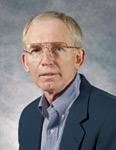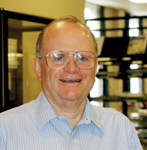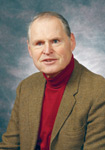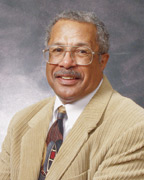Dedication personified
—by Peter Bankart
 Wabash thrives on tradition. It seems that anything that has happened more than once within any two-year period is almost instantly enshrined as an event that brings a nostalgic flood of tears to a Wabash man’s eyes. But from the perspective of those of us who have been around since Caleb Mill’s retirement dinner, few of these traditions are, in fact, either particularly venerable or destined to be particularly long-lasting.
Wabash thrives on tradition. It seems that anything that has happened more than once within any two-year period is almost instantly enshrined as an event that brings a nostalgic flood of tears to a Wabash man’s eyes. But from the perspective of those of us who have been around since Caleb Mill’s retirement dinner, few of these traditions are, in fact, either particularly venerable or destined to be particularly long-lasting.
By contrast, while Carl Thompson doesn’t quite have the historical tenure of the Monon Bell or oral comprehensive exams, he has been a fixture of the College and a pillar of the Psychology Department longer than any of our current students have been alive.
Carl’s retirement at Commencement in 2006 will mark the end of his 23rd year at Wabash, 19 of those having been spent as chair of the department. How to make sense of those numbers in a world where the shelf life of a professional athlete or a best selling author is less than that of a Silicon Valley start-up company? Consider the following facts about Carl’s career at Wabash.
By a conservative estimate, Carl has delivered more than 1,800 lectures to beginning psychology students, and this doesn’t count the 15 years he spent at the medical college at Pennsylvania State University before he came to Wabash. Over those 23 years the course’s name has changed, its number in the Wabash Academic Bulletin has changed, the pictures of the Presidents on the walls of Lovell Lecture Hall have changed (and some have disappeared); but for the past 46 semesters (with a little time off in-between for a sabbatical or two), if it was a Monday, Wednesday or Friday morning and it was between 10:20 and 11:10, everyone at Wabash knew where Carl Thompson was and what he was doing.
In fact, at least 60% of all of the College’s alumni who have graduated since the mid-1980s have taken at least one course from Carl, and I can’t recall a single instance when any natural or man-made disaster has kept the show from going on. Carl may have reluctantly missed one or two classes if he was laid low by the flu, but it would be a mighty foolish undergraduate who would take one look at the snow piled high against the windows of his fraternity or dorm, and go back to bed assuming that nobody was crazy enough to come to work on a day like this—because Carl Thompson was never deterred by a simple weather emergency or the fact that all the sane people were snugly at home. On days when there was only one car in the entire Center Hall parking lot, you knew at once whose car it was.
It’s probably less widely known that Carl has had a highly productive career as a research scientist. In addition to a book on the biopsychology of eating, which was published in 1980, Carl has authored and co-authored 40 published research papers, most of them focused on some aspect of what scholars refer to as ingestive behavior, but which most civilians would call "eating and drinking." Just about all of Carl’s research has been collaborative (full disclosure—this writer published a paper with him in 1987), and he has always been extremely generous about making sure that his students’ names appear on the front page of his publications, not just in an obscure footnote.
In recent days Carl has been working furiously (Carl, evidently, does not need any sleep) on a paper with the title Plasma Glucose in Rat Pups and Adults Given Chronic Insulin, which is co-authored with a faculty colleague (John Munford) and a cast of students.
In recent years one has been likely to discover Carl hard at work on the weekends in his lab in the deep recesses of the basement of Baxter Hall accompanied by his eight-year-old grandson, Trevor. Is Trevor learning the secrets of the neuroscience trade from his grandpa? Is granddaughter Nicole, age one, to become the next member of the research team? One thing that Nicole and Trevor are learning for sure—no matter how much snow is on the ground or how hard the wind is howling outside their bedroom window, if it’s 10:20 and it is a Monday, Wednesday or Friday, there is serious work to be done!
Peter Bankart is professor of psychology at Wabash.
A gem of a librarian
—by Robert Wedgeworth ’59
 As of June 2006, Larry Frye H’81 will have served 26 academic years as director of the Lilly Library since his arrival from Bethany College in West Virginia. This represents the longest tenure of any Wabash librarian since the Lilly Library opened in 1959.
As of June 2006, Larry Frye H’81 will have served 26 academic years as director of the Lilly Library since his arrival from Bethany College in West Virginia. This represents the longest tenure of any Wabash librarian since the Lilly Library opened in 1959.
Under Larry’s leadership Wabash continued to develop one of the outstanding library collections among liberal arts colleges of the Midwest, but it has been his leadership in transforming Lilly Library into a major online research resource for the campus that is his greatest achievement. Frye led the effort to automate the libraries of the 26 private colleges of Indiana, connecting them to each other as well as to other academic resources within the State and across the nation. This seamless integration of local materials with those available in other libraries and on the Internet has made Lilly Library an outstanding institution. Working with the Wabash faculty, Frye and the staff have positioned the Library as a central research and study resource for the campus, incorporating online databases for almost every discipline in which the College faculty teaches.
In addition to his academic duties, Larry has been a leader in local community charitable efforts. For 21 years. He has organized the local residential drive for United Way, recruiting the members of Wabash fraternities to assist with canvassing. He is also well-known in the community for his work with Habitat for Humanity and Meals on Wheels, and it is that volunteer work that he hopes to give more time to as he "retires" from Wabash. His intention to spend even more time in such activities comes as no surprise to any of us who know this man: Larry is warmly personable, with an infectious (and inimitable!) laugh, who is as passionate about service to people as he has been to libraries and the learning they provide.
Asked once why he remained at Wabash for the balance of his career, Larry replied, "It’s the students!" Named an honorary alumnus of the College in 2004, Larry retires this year to a well-deserved chorus of "Some Little Giant!"
Wabash College Trustee Bob Wedgeworth is the president of Pro-Literacy Worldwide, former librarian at the University of Illinois, and the former Executive Director of the American Library Association.
The historian as detective
—by David Stone ’91
 When I arrived at Wabash in 1987, I knew what I was going to do. After majoring in chemistry and economics, I would proceed to law school and a lucrative career as a patent attorney.
When I arrived at Wabash in 1987, I knew what I was going to do. After majoring in chemistry and economics, I would proceed to law school and a lucrative career as a patent attorney.
Reality, though, had other plans. For one, I found I hated lab. For another, I’d signed up for a freshman tutorial called "The Historian as Detective." Jim Barnes, following a Wabash tradition of combining his vocation and his avocation, taught a dozen wide-eyed and unshaven 18-year-olds the odd congruence between murder mysteries and historical research.
And I couldn’t get enough. In his first assignment I found out that noted African explorer Mary Lee Akeley had knocked eight years off her age, and I was hooked.
Not everything about that freshman tutorial went well. We wrote our own detective stories for Jim. Mine dealt with one freshman’s pair of love letters that were mischievously and mysteriously misdirected to the wrong girlfriends. It had the virtue of being based on an actual incident, but its virtues ended there.
Still, I kept coming back. Jim was my advisor when I got to Wabash, and I never saw any reason to change. I wanted to find out more, learn more, do more snooping. This culminated in a senior seminar in which Jim led history majors in tracing the lives of the early graduates of Wabash College: rich, poor, lawyers, ministers, farmers. A snooper’s delight.
I realize that I haven’t said a word about Jim’s blindness. It simply never mattered, and we never talked about it, even when he beat me at chess. It did come up in class. In a joke familiar to generations of Wabash men, Jim always told classes the first day to turn in papers neatly typed and double-spaced. Made it easier for his dog to read them.
Blindness also enforced a certain kind of classroom, one utterly in keeping with Jim’s personality. We had to maintain quiet order, courtesy, and decorum, taking turns and paying attention. For a man who studied some uncivilized people, Jim kept a very civilized classroom.
Now that I’m a history professor myself, I sometimes think about what it would mean to remember students by voice, not face. When grading a stack of papers, I need to flip back to page one by the time I get to page three. It is hard enough to follow the argument of an exam essay when I can look back to the top of the page. Yet from Jim I always got neatly-typed comments on my papers, knowing more about them than I did, and always finding something I could do better.
What really floors me, though, is Jim’s research. Historical research is like panning for gold. In an archive there are a hundred office supply requisition forms for one juicy memo. The only way to sort them out is to look, over and over, until eyestrain forces you to stop. I can’t imagine doing it without seeing.
Patience helps. By that I mean Patience Barnes, Jim’s wife and co-author. Academics have always needed the support of spouses, something that academia, to its credit, is beginning to understand. Jim and Patience showed how real partnership works in action, with eight books written and edited. Wabash will be sorry to see them go.
David Stone is assistant professor of history at Kansas State University and the author of Hammer and Rifle: The Militarization of the Soviet Union, 1926-1933.
He gave us room to lead
—by Alonzo Weems ’92
 My first visit to Wabash and the Malcolm X Institute of Black Studies occurred in Winter 1988 during the Dr. Martin Luther King Jr. visitation program. I still have vivid recollections of sitting around the classroom table in the MXI with a group of mostly black prospective students. At some point, Horace Turner H’76 was introduced to the group as the Director of the Malcolm X Institute of Black Studies. As I recall, he welcomed us, said a few words, and then turned the program over to Peter Keenan ’89 to facilitate a viewing and discussion of Eyes on the Prize. I saw Mr. Turner several more times that weekend but I didn’t really get a sense of him. He was clearly a man of few words yet he seemed to be involved in some way in the activities that occurred that weekend.
My first visit to Wabash and the Malcolm X Institute of Black Studies occurred in Winter 1988 during the Dr. Martin Luther King Jr. visitation program. I still have vivid recollections of sitting around the classroom table in the MXI with a group of mostly black prospective students. At some point, Horace Turner H’76 was introduced to the group as the Director of the Malcolm X Institute of Black Studies. As I recall, he welcomed us, said a few words, and then turned the program over to Peter Keenan ’89 to facilitate a viewing and discussion of Eyes on the Prize. I saw Mr. Turner several more times that weekend but I didn’t really get a sense of him. He was clearly a man of few words yet he seemed to be involved in some way in the activities that occurred that weekend.
Like my first visit to campus, a trip to the MXI played prominently on my first day of college. Admittedly, I don’t remember much about that first day of school but what I do remember is meeting a few other young black men, their parents, and again, Mr. Turner. He played quiet host to us and made himself available for questions.
In the weeks, months and the few short years that followed that first day of college, I got to know Mr. Turner—called "HT" by most. In response to my need for a campus job for a few hours per week, he hired me to organize the Institute’s library and to integrate the Institute’s collection into the circulation of the Lilly Library. In response to students’ need to get out of Crawfordsville to socialize, he secured available transportation. Need help finding a summer internship? HT kept the bulletin board just inside the MXI’s front door decorated with potential opportunities. Graduate or professional school? Ask HT and he would pick up the phone and call one of his contacts at Michigan or IU. He’s been a godsend for many.
Relentless in his insistence that students excel, HT was known for checking in on the progress of first semester freshmen—second semester too, if necessary—and pushing organized study tables at the Institute, with particular emphasis just before finals.
Perhaps HT’s greatest strength as the director over the years has been his willingness to allow a small cadre of young men, year after year, to be the faces and the voices of the Malcolm X Institute while he guided the daily operations, counseled on matters when needed, and secured necessary resources. He gave us room to lead and the room to just be what we wanted and needed to be.
Year after year, he has made the Institute a home away from home. He’s been one of the guys, while still being the director. He’s encouraged success, intervened at the first sign of impending failure, and kept up friendships with alums over the years and across the land. Though he steps away this year from the place he has made home for so many of us, he will always have a home in the hearts of the men of MXI.
Alonzo Weems is an attorney and serves as director of diversity at Eli Lilly and Company in Indianapolis.